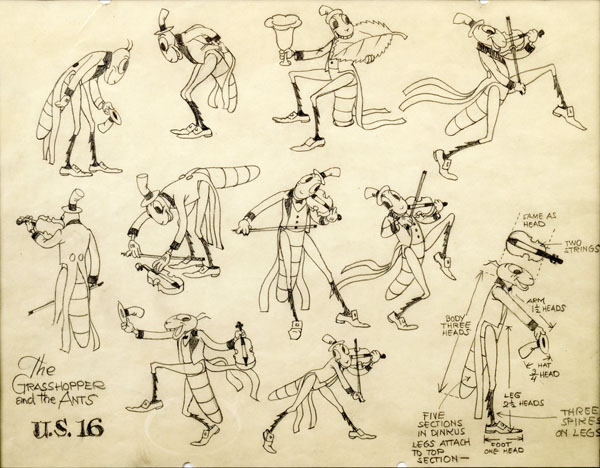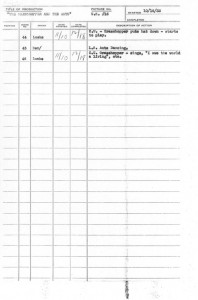Oh, the world owes us a livin’ in this week’s animation breakdown!

In September 1933, the story outline for The Grasshopper and the Ants, based on the Aesop’s fable, circulated around the Disney studio. While this film was in production, the directors—in this case, Wilfred Jackson—were no longer considered part of the story department, as was the case for their previous cartoons. The writers became responsible for developing an entire story line and establishing continuity for all new cartoons.
 Bill Cottrell, who started at Disney’s as an animation camera operator in 1929, joined the story department three years later. Unlike the other story men, Cottrell didn’t draw story sketches, but instead typed written continuities for the Silly Symphonies. By October 3, Cottrell’s continuity for Grasshopper was approved. On October 16—as indicated on the draft—Hugh Hennessy prepared the layout drawings for the film.
Bill Cottrell, who started at Disney’s as an animation camera operator in 1929, joined the story department three years later. Unlike the other story men, Cottrell didn’t draw story sketches, but instead typed written continuities for the Silly Symphonies. By October 3, Cottrell’s continuity for Grasshopper was approved. On October 16—as indicated on the draft—Hugh Hennessy prepared the layout drawings for the film.
Joe Grant, a former newspaper cartoonist, specializing in caricatures for the Los Angeles Record, was enlisted to design various Hollywood personalities for Mickey’s Gala Premiere. Grant’s caricatures for the Record were previously used for reference in a special Technicolor short, Parade of the Award Nominees, screened for the Academy banquet in November 1932. Enthralled by the animation process, Grant joined the studio on September 9, 1933—around the time production on Grasshopper started. He contributed inspirational story sketches on the film, working with colored pastels on his drawings. The results, remarkably different from the other story artists’ work, met with Walt’s approval. Grant teamed with Cottrell on Grasshopper, and on other subsequent Symphonies, including Who Killed Cock Robin and Three Orphan Kittens, both nominated for an Academy Award—and which the latter won.
Pinto Colvig, a jack-of-all-trades, provided the voice of the grasshopper, using the same vocals for Goofy. According to Cottrell’s continuity, it’s suggested that Colvig contributed much of the dialogue and lyrics for the “The World Owes Me a Living,” a worthy successor to “Who’s Afraid of the Big Bad Wolf?” from Three Little Pigs. Like “Big Bad Wolf,” the song warranted its own sheet music, with Leigh Harline credited for music and Larry Morey on lyrics. Various performers covered the song, including popular child actress Shirley Temple, in her film Now and Forever (1934).

“The World Owes Me a Living” is a theme of entitlement for the carefree grasshopper, as he sings and encourages the impressionable Andy Ant to shirk his harvesting duties. In the original fable, the famished grasshopper suffers throughout the cold winter, as the ants ignore his pleas. Besides his guffaws at Andy struggling with a cherry cart and falling into the mud, the cartoon’s grasshopper is more wholesome than condescending towards the ants’ work ethic. The ants clearly enjoy the grasshopper’s company, and the music he makes on his fiddle—one of the Queen ant’s royal subjects, holding her veil, is distracted by his music before he is whisked away.
At the film’s end, the song is reprised, as the grasshopper fiddles to entertain at the ants’ banquet, allowing him to work for food and shelter during the winter, his tune now changed to “I Owe the World a Living.” An omitted scene, indicated in one of the drafts for the film, has the grasshopper shaking his head at the ants as they work, before he notices Andy—it was possibly cut to justify the grasshopper’s reward.

Animation on Grasshopper started by November 8, with several animators handling different sections throughout the film—Dick Huemer animates most of the grasshopper’s scenes during the opening, and his interaction with Andy Ant. Dick Lundy proceeds during the meeting between the grasshopper and the Queen ant, and Bill Roberts handles the grasshopper fiddling away as summer, then autumn pass, and winter falls. Art Babbitt and Ham Luske handle the bulk of the grasshopper’s scenes up to the end of the film; Babbit animates the grasshopper trudging against the snow, forced against strong gales of wind, and crawling up to the ant’s banquet hall for sanctuary, while Luske animates all of the scenes with the grasshopper inside. (Lundy is credited for the grasshopper’s reprise of “The World Owes Me a Living” to the Queen, though it re-uses animation from an earlier scene, by Huemer.)
 The original typed draft—indicative by the template used in the papers—includes hand-written omissions and inclusions in the animator credits; for instance, Clark was intended to animate the Queen and her procession—instead, it was assigned to Leonard Sebring. Huemer and Clark were originally meant to share a scene, with the grasshopper and the Queen ant (now Lundy’s in the finished film), and “Frenchy” de Tremaudan was assigned to the grasshopper fiddling away as the seasons change (now Roberts’ in the film).
The original typed draft—indicative by the template used in the papers—includes hand-written omissions and inclusions in the animator credits; for instance, Clark was intended to animate the Queen and her procession—instead, it was assigned to Leonard Sebring. Huemer and Clark were originally meant to share a scene, with the grasshopper and the Queen ant (now Lundy’s in the finished film), and “Frenchy” de Tremaudan was assigned to the grasshopper fiddling away as the seasons change (now Roberts’ in the film).
Two animator drafts exist for this film—the original typewritten document used during production, and another version, from when many of the drafts were re-typed in later years. Scene 35—the ants’ banquet—is noted differently in both drafts; the original credits Ben Sharpsteen, presumably with Cy Young, or junior animators Ed Smith and Tom McKimson. The other draft credits Art Babbitt and Louie Schmitt for the scene, though Schmitt hadn’t worked on the film. Due to this inconclusive evidence, this particular scene is given no animator credit in the video.
The animation on Grasshopper was finished by January, and was released the following month on February 10, 1934. The version seen here is a re-issue from RKO, from July 1950—the original release version hasn’t surfaced as of this writing.
If you’d like to see more production materials based around this film, be sure to pick up a copy of Didier Ghez’s They Drew as They Pleased: The Hidden Art of Disney’s Golden Age, which contains several rare concept drawings from this film by Albert Hurter. John Canemaker’s Two Guys Named Joe contains many of Joe Grant’s caricatures from the Los Angeles Record, and don’t forget J.B. Kaufman’s revised Silly Symphonies book for additional data.
Enjoy, and for some of you with chilly weather (like myself), dress warm!
Here’s the original 1933 production draft (click to enlarge):




Below is the re-typed version of the draft:

(Thanks to Mark Kausler, J.B. Kaufman and Michael Barrier for their help.)


 DEVON BAXTER is a film restoration artist, video editor, and animation researcher/writer currently residing in Pennsylvania. He also hosts a
DEVON BAXTER is a film restoration artist, video editor, and animation researcher/writer currently residing in Pennsylvania. He also hosts a 




















































































Devon-
This is unrelated to this topic, but could you possibly do a post on Al Hubbard as part of your “Moonlighting Animators in Comics” series? Love his drawing style, it’s very easy to recognize.
Loved The Grasshopper and the Ants especially Pinto Colvig as carefree Grasshopper but I wonder who did the voice of the Queen Ant?
Please can you do a breakdown of Bob Clampett’s later cartoons?
Devon Baxter has posted over 90 Animation Breakdowns on Cartoon Research over the past 20 months – and he makes it look easy. But a lot of hard work goes into every one of his posts – part of which is in tracking down these rare animator drafts. These drafts are not commonplace. They were part of the production process and were often thrown away after the cartoons were completed.
Devon doesn’t have a “choice” of what cartoons to spotlight each week – he is at the mercy of what survives in the archives of the animators themselves, and from animation historians (like Mike Barrier, Hans Perk and Mark Kausler to name a few) who have found them in years past and saved them.
We all wish to see breakdowns from Clampett’s later cartoons too. We are speaking to the Clampett estate about this… but there are no guarantees. For now, lets enjoy what we have – and thank Devon for these incredible posts week after week.
Would you have any idea of the name of the musician who played the fiddle in this Silly Symphony. Family legend (never a good source) gas it that it was Paul Finstein, who had worked for Disney. Other family members claim he played in the Three Littke Pigs. I am not a very good researcher and have found nothing yet
I liked this cartoon as a child does anyone know if I can get a copy foe my grandkids ?
Was music deleted at the end for the re-release?